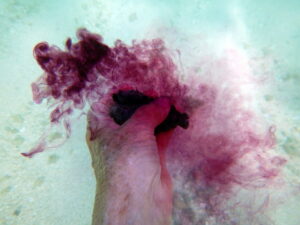
April 21, 2023
Last month, reader Carol Wilcox emailed that while snorkeling on Kahala Beach near Black Point she spotted a red filament-like fluid about the size of a baseball oozing from a shallow hole covered with limu. Floating low in the water column, the ooze moved with gentle wave action. Another squirt came out, then a third and a fourth. Some squirts opened like a net, others were opaque and stringlike.
“When I gently lifted a section with my finger it all held together, much like a spider web,” Carol wrote. “The color was a deep purple red… Any ideas?”
Several of us had ideas. I sent Carol’s question to author John Hoover who, like me, wondered if a sea cucumber had ejected its guts. But the tubules that some sea cucumbers expel when disturbed are white and sticky, and sea cucumber gonads, when expelled under duress, aren’t fluid.
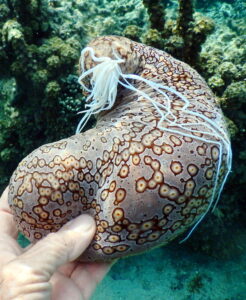
This sea cucumber’s defensive ejected threads stuck to my fingers for hours. ©Susan Scott
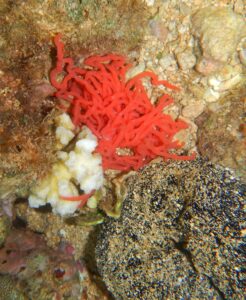
An unknown threat caused this sea cucumber to eject its red gonads. (They can grow back.) ©Susan Scott
John also thought of the hermit crab anemone that ejects pink threads when disturbed, but those aren’t fluid either.
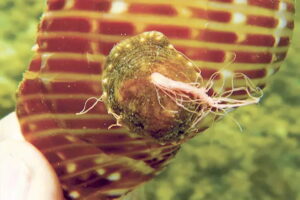
This hermit crab anemone clinging to a broken tun shell spewed its pink threads when I picked it up. ©Susan Scott
Because neither of these creatures seemed quite right for Carol’s description, John passed the question to Cory Pittman, an expert on Hawaiʻi’s marine invertebrates who, with Pauline Fiene, manages the Sea Slugs of Hawaii website.
Cory agreed that the above animals don’t fit the story and suggested that, most likely, it was a sea hare releasing its defensive ink.
That reminded me of an experience I had while snorkeling on Oahu’s North Shore in 2020. A rapidly rising surf had cut short my swim, and while exiting the water, I found a sea hare rolling at the shoreline. The strong current had dislodged the sluglike animal from its rocky home.
I picked up the sea hare, and the distressed creature began oozing a reddish liquid, much like an octopus’s ink, except purple.
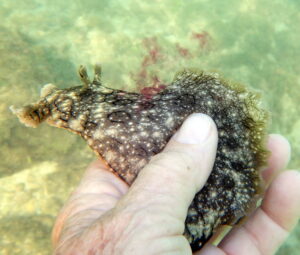
The first tiny puff of peril. ©Susan Scott
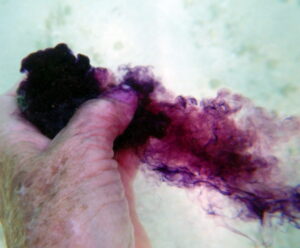
My rescue sea hare in full alarm. ©Susan Scott
With waves breaking on me, and the current pushing me sideways, my rescue turned into a struggle. (Safe enough in shallow water, but hard work.) By the time I found a proper puka in which to lodge my saved sea hare, I forgot about the creature’s initial purple cloud.
But my camera didn’t forget. After Cory suggested sea hare ink, I remembered the pictures I’d managed to take before swimming back into the surf.
What threw us all off was Carol’s statement that the cloud held together like a web. In all the accounts I’ve found, including my single experience, a sea hare’s ink cloud dissolves like any other liquid. Sea hare ink may be our best guess, but it’s possible Carol saw something else entirely.
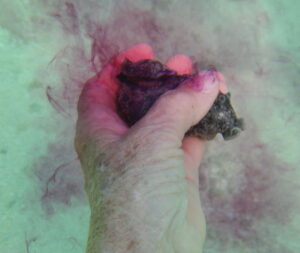
There was nothing spider-webby about this cloud. It dispersed quickly in the swirling water. ©Susan Scott
Sea hares are plump sea slugs that get their name from sensory organs on their heads that look a bit like bunny ears. Hawaii hosts several species ranging in size from about two inches to 10 inches long. The Hawaiian name for them all is kualakai. All are algae eaters. Kualakai that eat red algae emit reddish-purple fluid when upset. I’ve rescued countless sea hares over the years, but this was the first one that inked me. When red algae is absent from a sea hare’s grazing area, the animal emits no ink.
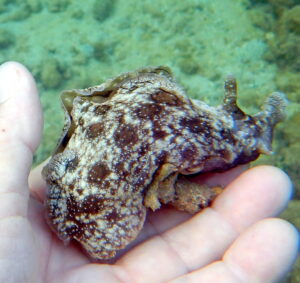
A no-ink rescue. The creature’s muscular foot is still hanging onto the rocks (in my hand) it had grasped in a failed attempt to anchor itself to the ocean floor. ©Susan Scott
Most sea hares are nocturnal, hiding during the day and coming out at night to eat. Unlike some of their brightly colored sea slug cousins, sea hares blend with their backgrounds so well it’s easy to miss them.
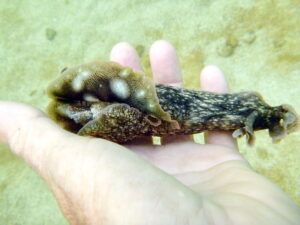
Another no-ink rescue. When I find sea hares adrift, I tuck them into a secure crevice in the reef. ©Susan Scott
Researchers have discovered anticancer and antibacterial substances in the ink of a sea hare species found throughout the world’s tropical waters, including Hawaiʻi. You can see photos of that oddly-shaped species, Dolabella auricularia on Cory and Pauline’s site, here. I’ve not this seen one, but now I’ll be looking.
Years ago, my UHM invertebrate zoology professor, Mike Hadfield, took our class to the Diamond Head reef flats at low tide. My first discovery there was a white-speckled sea hare, Aplysia argus. I’ve been admiring (and rescuing) these charming marine bunnies ever since.
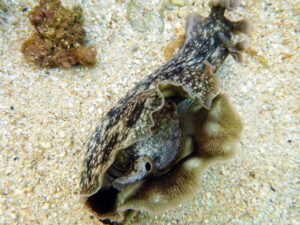
This sea hare’s back flaps are open here during another rescue. Speckled sea hares are common in my snorkeling area where surf often dislodges them. Of all my rescues, only one has spewed ink. ©Susan Scott
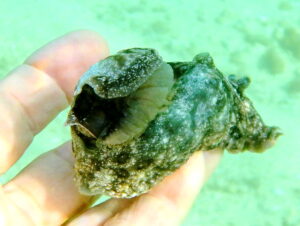
The frills on the this sea hare’s back are the creature’s gills. ©Susan Scott
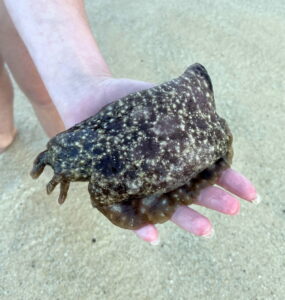
Speckled sea hares grow to about 8 inches long. Recently found (and relaunched) on Lanikai Beach. ©Marya Grambs photo.